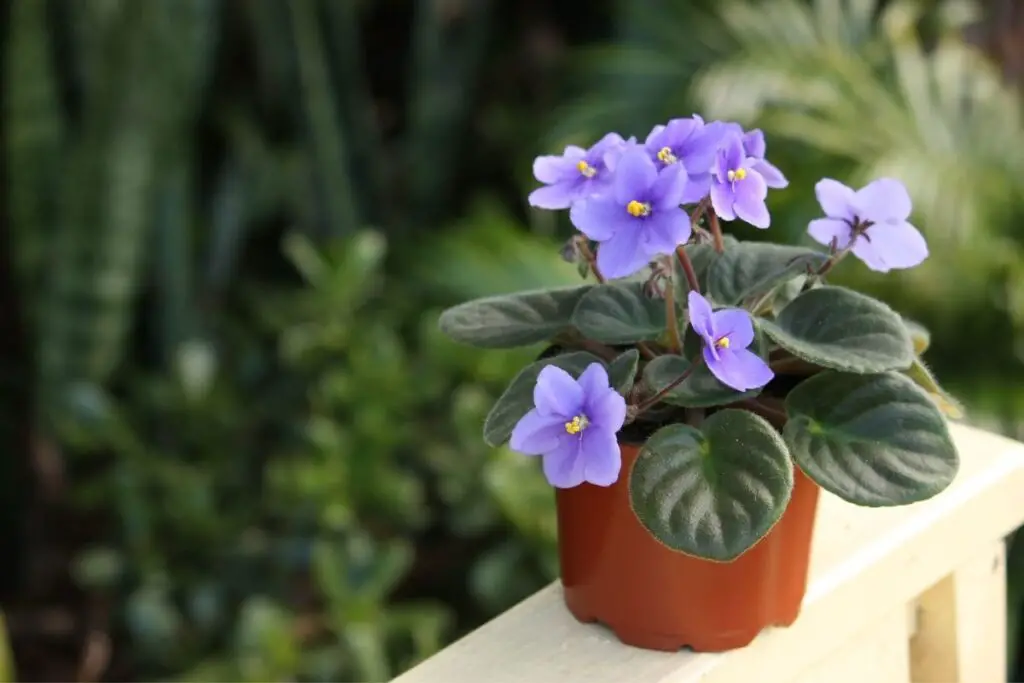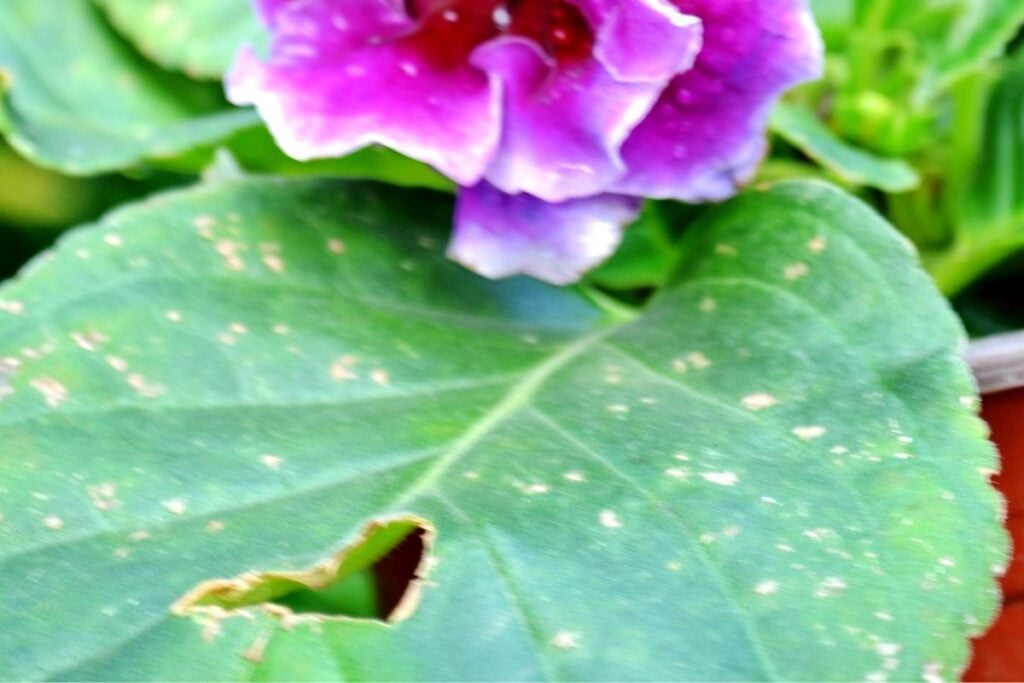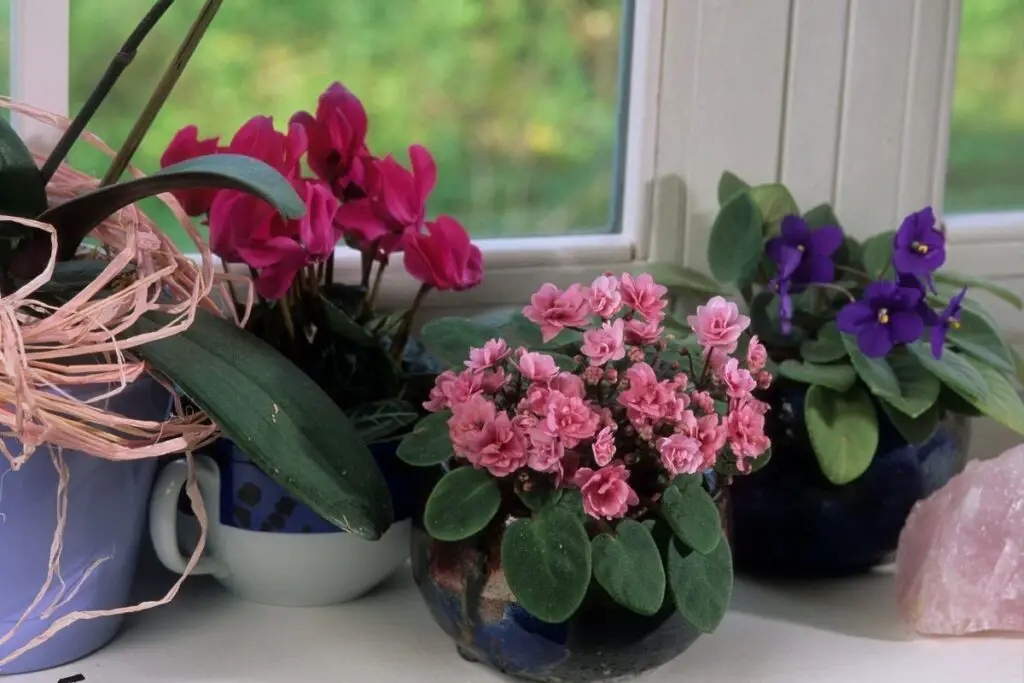If you are planning to grow African violets in your garden, you must understand their light requirements. In most cases, these flowers are treated as indoor plants, but sometimes, they can be grown outdoors if planted in a place where they can receive indirect or filtered sunlight.
So, in this article, we shall discuss what kind of light do African violets need?
African violets need indirect sunlight for at least 8-10 hours a day as direct sunlight is too intense and causes leaf burn. Keeping them on the east or north side of your home would be ideal. You can supplement their lighting needs by using artificial light during the winter months.
You must note that African violets need the right amount of indirect sunlight for better growth. While protecting them from direct sunlight, if they get entirely deprived of light, that will lead to light deficiency, further inviting other problems.
If you want to learn more about the kind of light African violets need for healthy growth, continue reading this article. We will also discuss the light requirements of these flowers in detail.

Do African violets need direct sunlight?
African violets are mainly popular houseplants because they do not want or need any direct sunlight. But, yes, they can also be grown as outdoor plants if they get the right kind of light.
African violets need a moderate amount of indirect sunlight. Direct sun rays act intensely for these flowers, resulting in sunburns, so filtered light works well for them.
However, they can tolerate direct sunlight mainly in the early morning and late afternoon times, when the sun rays are not so intense anymore, and thus they do not harm these plants.
If you are growing the African violets outdoors, you might need to find a suitable site where they will not receive direct sunlight.
You can also give them protection by making an artificial shade that might work as a filter so that the flowers can get filtered sunlight.
If you want to check whether the sun’s rays are intense or not, you can keep your hand over the flowers that are receiving sunlight and feel the warmth.
If you feel that the sun’s heat is too much, the light is harmful to the flowers. And if the heat doesn’t feel so warm, then it won’t be harming your violets. You can create a shade to protect them from the harmful warm rays of the sun.
How much sunlight do African violets need?
African violets grow best when they receive indirect sunlight. They need at least 8 to 12 hours of light every day.
For blooming for an extended period, the African violets need at least 12 hours of natural sunlight daily to survive throughout the day. And they need bright light during the day.
In spring, summer, and fall, the sun rays are too intense for the flowers during the afternoon time.
It is better to provide these flowers with some shade and filter to protect them from heat damage in such conditions. Filtered sunlight will be ideal for them.
During the winter season, the bright light of the sun works well for the African violets.
During the winters, the sun’s rays are not so intense as in summers and springs. Even in the afternoons, the flowers can withstand the sun in winter.
Do African violets need light during the night?
It is not essential to give your African violets light during the night.
Some gardeners say that they need a minimum of 8 hours of light per day and per night, respectively, but they need to remain in darkness.
African violets need to receive 8 to 9 hours of darkness each day. So basically, after around 10:00 PM, the violets no longer need any light. Darkness works as a bloom cue for these flowers.
So, you don’t need to make any extra arrangements for providing extra light at night.
Looking for gardening supplies? We have tested 100's of products before recommending them to you guys. Check out our best pick below:
| Image | Gardening Supplies | Best Price? |
|---|---|---|
 Top
Top Top
Top | Raised Garden Bed Kit | Check On Amazon |
 | XLUX Soil Moisture Meter, Plant Water Monitor, Soil Hygrometer Sensor for Gardening, Farming, Indoor and Outdoor Plants, No Batteries Required | No Results |
 Top
Top Top
Top | 82 Pcs Garden Tools Set and Extra Succulent Tools Set | Check On Amazon |
 | Joeys Garden Expandable Garden Hose with 8 Function Hose Nozzle, Lightweight Anti-Kink Flexible Garden Hoses, Extra Strength Fabric with Double Latex Core, (50 FT, Black) | No Results |
 Top
Top Top
Top | Dual Chamber Compost Tumbler | Check On Amazon |
 Top
Top Top
Top | Sunnyglade Plant Stakes | Check On Amazon |
 Top
Top Top
Top | Organic Cold Pressed Neem Seed Oil | Check On Amazon |
 Top
Top Top
Top | Mighty Mint Gallon :-Insect and Pest Control Peppermint Oil | Check On Amazon |
 Top
Top Top
Top | Scotts DiseaseEx Lawn Fungicide | Check On Amazon |
 Top
Top Top
Top | Jacks Classic 20-20-20 All Purpose Fertilizer | Check On Amazon |
 Top
Top Top
Top | 30,000 Seeds Pollinator Attracting Wildflower Mixture | Check On Amazon |
 Top
Top Top
Top | Survival Vegetable Seeds Garden Kit-Over 16,000 Seeds | Check On Amazon |
How many lumens of light do the African violets need?
The African violets can grow well if they are kept under indirect sunlight for 12 hours. But, it is necessary to know about the quantity they need.
African violets need 5,000 to 13,000 lux at least for 12 hours throughout the day for a healthy blooming. One lux means lumens per square meter.
The older African violets need to receive light ranging between 10,000 and 15,000 lux to remain happy and healthy. The younger African violets need to receive less light, ranging from 5,000 to 8,000 lux, for remaining healthy and strong.
You cannot naturally know these measurements. If you want to keep your violets healthy and long-lasting, then learn these measurements for their ideal growth and to know whether the light they receiving in these ranges or not.
You can use a light meter to detect the range. You can also use your phone to detect the range by downloading a light meter app.
Can grow lights be used for African violets?
Generally, the African violets will grow well if they receive bright and indirect sunlight throughout the day. But if they receive insufficient light, then they would no longer remain healthy.
Sometimes, during the winter and cloudy days, the sunlight is rarely seen throughout the day, and insufficient light problems arise in such conditions.
You can solve the problem by using grow light for your African violets. If you make the correct usage of grow light for your African violets, it will help your violets grow at a fast rate, and they will produce a flush of colorful blooms.
Set the lights at 12-15 inches above the plants, depending on the power of the lights and the size of your African violets.
Remember, you do not have to give light all the time to your African violets.
You can set a timer for setting the light on for 14 hours and off for the rest of 10 hours. In these 10 hours, the plant will remain in the dark. They also need darkness for producing flowers and lasting long being healthy.
Let us read in brief the benefits of using grow light while growing African violets:
Better performance
African violets perform best when they are receiving a lot of indirect sunlight. But sometimes, the sunlight doesn’t remain the whole day, especially during the monsoon months.
In such conditions, you can use grow lights for better performance in the flowers. Somewhere around the garden, you can arrange and adjust grow light so that it helps your plant to grow more productively.
Better growth
Using grow light will allow for better growth of the African violets. You can even grow these plants in any season you want. You don’t have to be worried about the weather conditions, especially if there is less sunlight outside.
You can use grow lights to help the African violets grow better because they will constantly get all they need through these artificial lights.
If you are using grow light for the African violets, make sure that you use both blue and red light spectrums because these two are the essential rays these plants need for better survival.
What happens when African violets receive excessive sunlight?

I have already mentioned that African violets do not enjoy direct sunlight.
Now, let us see what happens when they are exposed to too much sun:
- When exposed to the excessive sun, the first and foremost symptom is droopy leaves in the violet plants. The leaves will start curling inwards when they get too much sun.
- If, after this sign, still your plants are kept under the sun, they will begin to turn yellow.
- The more time they remain exposed to the sun for a long time, the more symptoms increases. The leaves start developing brown spots and sunburn marks on their surface.
- If there are any flowers already present in the plant, those blooms will start fading and will finally start dropping off.
What happens when the African violets do not get enough light?
Like the plant can get affected after being exposed to the sun for a long time, similarly, when they are not getting enough light, that can also affect the plant.
Some possible signs to identify the problem are as follows:
- If your African violets are not getting enough light, they will have stunted growth.
- The leaf stems of violets will start turning long, and there will be less leaf growth due to the lack of light.
- The leaves will start to grow upwards towards the light.
- The plant will not bloom more flowers due to low light, and no new buds will appear.
What is the best spot for growing African violets?

African violets do not like direct sunlight at all. Especially during the spring, fall, and summer, when the sun’s heat is too hot to handle, these violets won’t be able to withstand the sun’s intense rays.
Sometimes, it becomes risky to grow them outside. But still, if you provide them with all their requirements and protect them from the direct sunlight, they can survive.
If you want to grow the African violets outside, you first need to choose a good site for them whether the sun will fall, but it won’t be too harsh.
You can also choose a site where there are some tall trees around, which might protect the violets from the sun’s harsh rays by doing the job of a filter.
You can also create artificial shade to protect them from the intense sun rays by using transparent clothes or unused curtains. If they get exposed to the direct sun while being wet, it might cause sunburns. So protection is necessary.
While growing them outdoors, you need to determine the different directions of the sun at different times and seasons. You can plant the African violets on the north or eastern side of your garden.
During summer and spring, the sunlight becomes too intense for the violets to handle. Thus planting them in the north or east will help protect them from the direct sunlight.
Growing them on the south or west side will be beneficial during the winters.
But as winter remains for only a couple of months, and the afternoon sun is intense during the months, it is better to plant them in a spot where they won’t be receiving direct sun. If any time they lack light, it can be managed with grow lights.
Another thing you need to know is the temperature in your area. African violets survive well when grown in temperatures ranging between 70-90°F in the day and 65-70°F during the night. They will not survive extended periods beyond these temperature ranges.
Final words
Growing the African violets outdoors might be tricky and risky, but their light requirements are pretty straightforward.
Grow them in a place where they can receive indirect sunlight for at least 12 hours for ideal growth.
Try to feel the strength of the heat by placing your hands above the flowers. You can use the protection (artificial shade) if required. Make the shade in such a way so that you can remove it anytime if necessary.
You can always use grow lights as an alternative for low light issues in the plant to help them survive for a long time. It would help if you opted for both blue and red lights for better performance.
Do not forget to maintain both the light and dark cycles, which are 12 hours of light and 8 hours of darkness, to keep them healthy and promote their blooming.
Observe your plants daily to check whether your plant is doing well in their planting site. Check if they show any signs related to light issues, like yellow leaves, leaf curls, faded flowers, brown spots, etc.
Take good care of them and provide all the other requirements to help them survive and remain alive for an extended period.
Source: Wikipedia, African violet: Classical breeding, African Violet Society of America, In vitro propagation of African violet, University of Florida, North Dakota State University, The University of Georgia.
